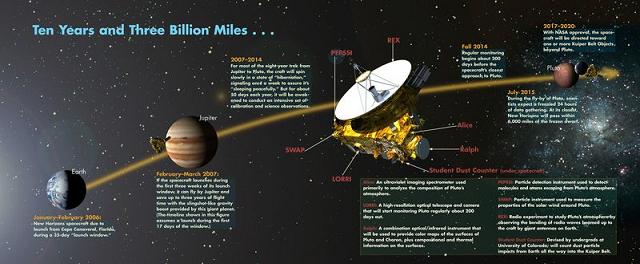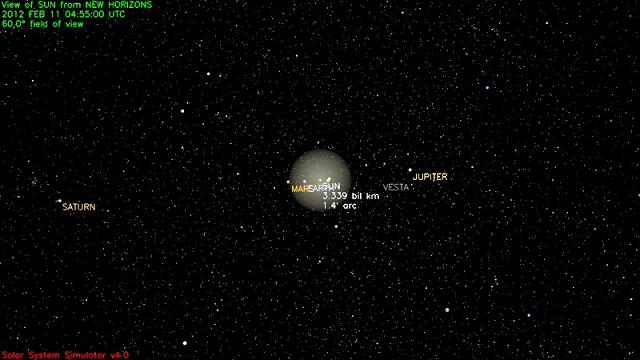|
SPACECRAFT SPRINTS TO WITHIN A
BILLION MILES OF PLUTO
Analysis by Ray
Villard Feb
13, 2012

On Feb. 10, NASA's Pluto-bound New Horizons probe
entered the home stretch of its mission.
When you are sprinting across the solar system,
"home stretch" is the final one billion miles of
your journey. That sounds like quite a stretch, but
the half-ton spacecraft has already logged two billion
miles since its launch in early 2006. That’s twice
the distance between Earth and Saturn.
Though the icy dwarf planet is still three years
away from the Plutonian close encounter, mission
scientists call this the Late
Cruise phase
of the flight.
ANALYSIS: Pluto May Live in a Rough Neighborhood
The nuclear-powered probe will zoom by Pluto, its
moons, and possibly navigate a hazardous
ring system on
July 14, 2015.
Even if the space traveler had artificial
intelligence (as its distant descendants will), it
would still be unaware of crossing this milepost --
the spacecraft's electronics are in hibernation.
Controllers at the Johns Hopkins Applied Physics Lab
in Laurel, Maryland will awaken the onboard computer
in late April for a two-month-long systems and
instruments checkout.
Flight engineers will conduct a 24-hour long
near-encounter rehearsal to exercise the spacecraft.
During this test New Horizons will make every
maneuver, every instrument scan, and every
observation that it actually will do around closest
approach in 2015.
Housekeeping chores also include checking out each
of the seven scientific instruments, updating
software to the onboard command and control
computer, and removing a bug that occasionally
causes it to reset. (Presently it takes nearly three
hours for radio commands from Earth to travel at the
speed-of-light to the probe. New Horizons can't just
call tech support!)

At the spacecraft’s present distance much of the
solar system fits within a panoramic field of view.
The sun is reduced to a bright dot seen against the
backdrop of constellations, midway between Gemini
and Orion. The sun is glowing at one-four hundredth
its brightness as seen from Earth. The inner planets
are clustered near the sun within an angular
diameter equivalent to eight moon diameters. Jupiter
appears as a bright star 10 degrees to the west of
the sun. Saturn looks like another bright star 25
degrees to the east of the sun.
ANALYSIS: Pluto, Sponsored By McDonalds
The fastest manmade object ever built, New Horizons
covers nearly a million miles of space each day.
Blazing out of the sun’s gravitational well at
34,000 miles per hour; the probe could travel from
Earth to the moon in just six hours.
In October 2013, New Horizons will be just 500
million miles from Pluto. In March, 2015 that
distance will shrink to the Earth-sun separation of
93 million miles. Fully awake, New Horizons will
train its cameras on the fast approaching planetary
target.
This will complete a five decade-long initial
reconnaissance of the solar system. And, I predict,
the stunning views of the remote world will return
Pluto to full planetary
status in
the public mind.
Images: NASA
Source: Curiosity |



